Fire and Water
(steve)
Fresh from our fleecing on Kangaroo Island, we embarked on a long drive stretch to get to the Melbourne area. Our route took us through a large expanse of farmland, complete with rolling hills and lots of cows. There are two attractions along the way to keep us entertained. First up, Grampians National Park.
We rolled into Hall's Gap after about 7 hours worth of drive and ferry time. We were good and ready to get out of the car. Especially for me, the last hour of drive was a little nervous, since it was completely dark at this point and there are loads of kangaroos that like to hang out right next to the road after sunset. As you drive around the countryside the freeways are littered with carcases of the poor beasties, making a roo strike all too real a danger.
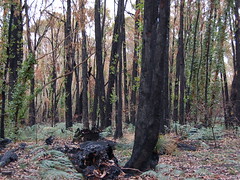
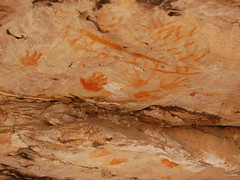
The Grampians lie in a park about 150 km west of Melbourne, making them a popular weekend spot for locals escaping the city. To complicate matters for us, our arrival coincided with a public holiday, the Queen's b-day. After not having to deal much with crowds during the winter, there were a lot of cars and folks about the place. Luckily, we found a room in one of the local hostels. The next day was spent touring the park. This park tour was different from others in that the surrouding forest was recently burned in a fire (last January). It was very interesting to see the trees in recovery mode. For eucalpyts, the first step is to shoot out a load of leaves from the trunk of the tree itself. This made the forest look like a collection of stumps covered with moss. Much like sequoias, fire is necessary for the trees to complete the reproduction cycle, with the heat releasing new seeds. At the same time, the forest floor begins to recover with a new carpet of ferns that spring up. Overall, the forest doesn't look like it suffered too much damage. Compare this to the result of a fire around southern CA. The Grampians is also home to a number of Aboringinal rock art sites. We visited two of them for your viewing pleasure.
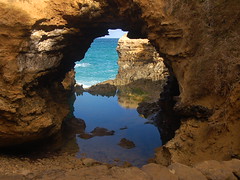
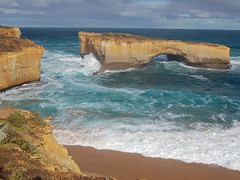
The second attraction was the Great Ocean Road. This is a 300 km stretch of highway that runs along the coast from Warrnambool to Geelong known for gorgeous scenery and dramatic landscape. We began the drive with a stop at the beach in Warnambool, where we heard a pair of southern right whales had arrived to give birth. The town is fascinated with these creatures, building a viewing platform for easy access. We joined a host of locals and watched as the two rolled just outside the breakers, coming up for air every couple of minutes. Nature at work. With a warm fuzzy, we headed out on the road.
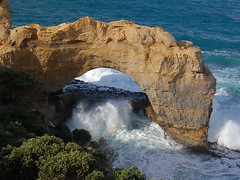
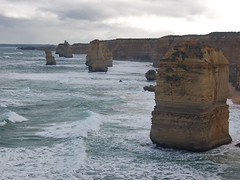
The Great Ocean road runs along coastline carved from sandstone at a rate of 2 cm per year. This rapid erosion leaves lots of arches, caves, and pillars standing (temporarily) in the surf. Combined with turquoise water, the scene was beautiful to behold. We lingered at colorfully named spots like Bay of Martyrs and the Twelve Apostles. This coast is also infamous for shipwrecks, hence the reverential names. Unfortunately for us, rain showers lingered with us for the day too. The drive was longer than we expected, but worth the effort.


1 Comments:
Sorry to hear Kangaroo Island was a bit of a rip off. The pics are good though. How was the ferry ride? The seas get a bit rough in the winter.
7:31 AM
Post a Comment
<< Home